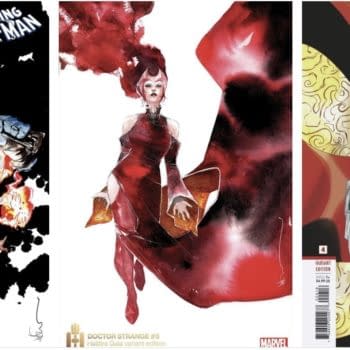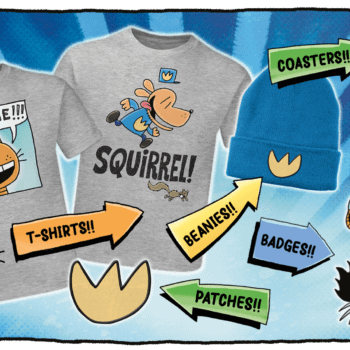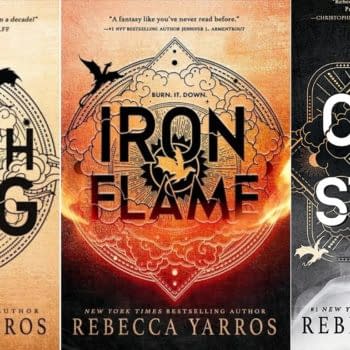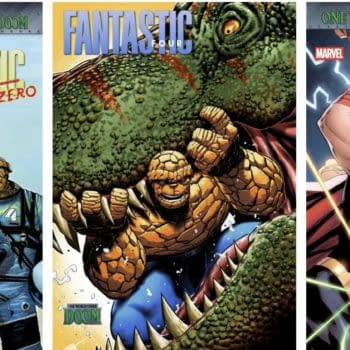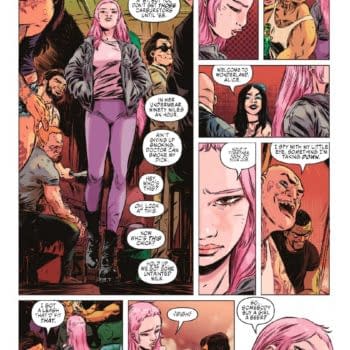Posted in: Comics | Tagged: book festival, clive barker, Comics, edinburgh, neil gaiman, sandman, stripped
Returning To Sandman. Neil Gaiman, Stripped Multiple Times

Neil Gaiman has always been one of the hardest working writers in any medium, with multiple books, films and comic books on the go at the same time. But even he was really pushing it to the limit at the Stripped strand of the Edinburgh International Book Festival. Not content with multiple press interviews, co-interviewing with Grant Morrison, hosting evening events, taking over the Book Festivals twitter stream, four talks and at least SIXTEEN hours of signing he also helped organise the whole strand by making some of the phone calls required to persuade some of the talent to attend. Yes, Gaiman was everywhere in Edinburgh and at all times he was his usual thoughtful charming self.
For each of his four talks they were themed round a specific subject. Not many writers have enough material to be able to do four entirely diffent hours that but it really felt like Gaiman was barely scratching the surface of the stories he had to tell that weekend. His first talk was with Charles Fernyough to discuss his adult's novel The Ocean at the End of the Lane. Second was a wonderful talk about his kids book: Fortunately, The Milk with Vicky Featherstone director of the Royal Court the fun was in having the kids asking all the questions. They had no reserve and Neil played up on this beautifully. Third talk was with graphic novel creator Hannah Berry to discuss Sandman. And finally with Margaret Atwood to discuss stories. All four talks were jam packed and the organisers ran the signings in as slick a manner as someone signing 1000 books at a time could possibly be!
If you haven't already guessed the talk I'm reporting on here is the one he did with Hannah Berry on Sandman. And how fitting it was that Gaiman was going to be talking about Sandman, his real big break and what may be, his finest work. There was one person at least really looking forward to it, and totally nervous about the talk, Hannah Berry, the chair! This was something that Neil Gaiman playfully played up on during the talk on several occasions, teasing Berry mercilessly about her nervousness, all to a hilarious response by the audience, and Gaiman choosing to end the talk by asking the audience to thank Berry, not him.
And actually Berry didn't really have that much to do, Gaiman has been doing this so for so long now, all she had to do was ask one tiny wee question and he was off. This talk felt like one he NEEDED to do, it being 25 years since work started on the epic series. Yes, can you believe that it was 25 years ago already? And how appropriate that he was talking about this book at a literary festival where the work he and so many others did all those years ago has now been accepted to be a legitimate equal art form.
Gaiman started off with telling the story of WHY comics. He said even at 15 he knew writing was what he wanted to do and was utterly convinced comics were important, valuable and valid. Going down to Dark They Were and Golden Eyed buying Warrior and following Alan Moore's writing in Swamp Thing also (Moore's spectral presence looming over the festival yet again). Then going to his careers advisor saying that what he wanted to do was write American comics. Naturally the adviser being totally confused and nonplussed by this and suggesting he becomes an accountant instead!
As is obvious Gaiman didn't give up, as he at some point during his proto journalistic career sent his first book to Alan Moore for feedback. And nervously phoning Moore up to see what he thought of it. At this Gaiman did a cracking impersonation of Moore's Northampton apocalyptic drone "Lost a week's work", and Moore then giving Gaiman advice on just how do you write a comic strip….again in the Moore drone "page 1, panel 1". Suffice to say Gaiman has audience in palm of his hand by now. And this was all from a two word question!
But as I've said this was part of the fun, wind him up and let him soar. We were already 15 minutes in so Berry swiftly moved the discussion onto how did Sandman come about? Gaiman and McKean had already done Black Orchid for DC on the back of their fabulous Violent Cases for Escape Books. And in even more synchronicity Escape Books publisher is Paul Gravett also in attendance at the Festival. But I digress, Berger felt that they needed something else to launch a weird 3 part story about a barely known character from an earlier time, and would he pitch her a series? Oh and McKean can you draw a Batman book by Grant Morrison. The resonance just would not stop this weekend. Gaiman then having to trawl through DC's characters for something to write, eventually settling on The Sandman by Simon and Kirby. He did an 8 issue outline for one story, thinking that DC would probably cancel the book at issue 8, leaving him time to write 4 stand alone stories and the series would be done. Well that didn't happen, the book kept growing and growing. And as we know at that time comics were never just finite series. It was always the intention that if a writer or artist left and series was successful then it just kept going…Gaiman was having none of that saying in EVERY interview if it doesn't end then he'd never work for DC again. Berger then phoning Gaiman up to see how he would actually feel finishing Sandman.
Now we come onto the bit that some people have misinterpreted. In 1989 Rolling Stone writer Michael Gilmore revealed that he was including Sandman in his hot items of the year and asked if DC would like a cheap advert in that particular issue. At that time regular ongoing comics were not collected as a matter of course immediately after the completion of a story. DC had nothing to sell so literally overnight Gaiman persuaded Clive Barker to write an introduction, McKean the cover and for some bizarre reason the second storyline The Doll's House was released as a graphic novel. And it sold, but Gaiman said that it didn't sell because of the ad as no one phoned the number on the ad at all. And this is the important point to note here, it wasn't the first graphic novel, but it did set a trend in comics publishing where ongoing material is packaged up and sold. It also can be argued that Sandman showed there was a market for grown up comic books that people would buy and keep buying. I have to argue that we were in heady times at this point what with Watchmen and The Dark Knight Returns kicking off so that may be a moot point. But what I can say is that it's a legitimate part of what has taken us to the point where comics can be celebrated at a literary festival without a Biff a Bang or a Kapow in sight.
Berry then asked Gaiman how writing Sandman shaped his writing? To which he said it turned him into a storytelling machine where there wasn't a minute between 1987 and 1996 where he wasn't thinking about it. And to keep up the Sandman theme Gaiman was then asked about Overture his upcoming journey back into the Sandman universe with JH Williams III. Gaiman said he some ideas left over, unused, and there if he got round to them, such as why was Morpheus so tired at the start of the book.
He was asked by Karen Berger if he wanted to write this story up for the Sandman's 20th anniversary. Yes, but not on same original contract where Dave McKean earned as much doing one cover as he did writing the entire book. Well that was the end of that discussion. But DC came back again for the 25th anniversary, and this time a new contract was in place. Still just a quarter of the royalty rate he gets for a prose novel, but he's doing it for love.
Now the next bit I found surprising is that Gaiman has been finding the script hard to write. He's been getting stage fright with the weight of expectations of the entire world waiting for the book, and has been writing incredibly slowly. There's also the matter of JH Williams astonishing artwork, with Gaiman describing Williams as a genius and he can't reply to Williams emails when he send the work over as he is exulted at the artwork.
And there we have to leave it with a rummage in the past while moving forward. It was truly wonderful wander through much discussed territory that felt as fresh as the first time he had told these tales. As I've mentioned previously this felt like the spiritual end to the Stripped strand at the Edinburgh Book Festival. It wrapped up everything in a bow, what with the synchronicity, Moore's massive looming presence, how Sandman had a huge part in changing the comics publishing industry.
And for me the truly special thing about how this wrapped things up, it has genuinely taken 25 years for grown up comics to seep into the consciousness and just be a part of the culture without being looked down upon. Also a baton passing moment with Gaiman getting the audience to thank Berry, not him, Gaiman and other creators creating the roadmap that allows Berry and others to follow their own singular paths down that road.






